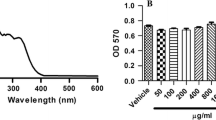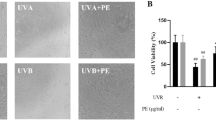Abstract
Background
Ultraviolet B (UVB), a major cause of skin photoaging, leads to DNA damage directly and indirectly in skin cells. DNA damage can contribute to aging by increasing apoptosis, cellular senescence and cell dysfunction. To prevent photoaging and rejuvenate photoaged skin, combinations of active compounds from natural products are used for medicine and cosmetic ingredients.
Objective
In this study, we investigated the synergistic effects of Rg2 and piceatannol (PIC) mixture (RP) on protecting skin against UVB-induced DNA damage in HaCaT cells.
Results
Cells treated with RP for 24 h post UVB exposure increased the cell viability in a concentration-dependent manner compared to non-treated control. In DPPH and DCF-DA assay, RP showed similar free radical scavenging activity to that of single-treatment PIC. RP more decreased the levels of CPD, DDR proteins including p53, p-p53 and p21 and apoptosis-related proteins, such as Bax, Bim, and cleaved caspase-7 than that of single-treatment PIC or Rg2. Also, RP decreased more the mRNA level of MMP-1, -3 and -9 than that of single-treatment PIC or Rg2.
Conclusion
It is inferred that Rg2 promotes DNA repair by regulating genes related with DDR and PIC promotes DNA repair by effectively scavenging UVB-induced ROS through high antioxidant activity. Enhanced DNA repair by RP leads to protecting skin from UVB-induced skin photoaging.




Similar content being viewed by others
References
Alessio N et al (2021) Biomolecular evaluation of piceatannol’s effects in counteracting the senescence of mesenchymal stromal cells: a new candidate for senotherapeutics? Int J Mol Sci 22:11619
Barzilai A, Yamamoto K (2004) DNA damage responses to oxidative stress. DNA Repair (Amst) 3:1109–1115
Chae S et al (2010) A comparative study of the potential antioxidant activities of ginsenosides. J Food Biochem 34:31–43
Chung YH et al (2018) Protective effects of ginsenoside Rg2 and astaxanthin mixture against UVB-induced DNA damage. Anim Cells Syst (Seoul) 22:400–406
Cordova-Gomez M, Galano A, Alvarez-Idaboy JR (2013) Piceatannol, a better peroxyl radical scavenger than resveratrol. RSC Adv 43:20209–20218
Crochemore C et al (2002) Enhancement of p53 activity and inhibition of neural cell proliferation by glucocorticoid receptor activation. FASEB J 16:761–770
de Jager TL, Cockrell AE, Du Plessis SS (2017) Ultraviolet light induced generation of reactive oxygen species. Adv Exp Med Biol 996:15–23
Emri G, Horkay I, Remenyik E (2006) The role of free radicals in the UV-induced skin damage. Orv Hetil 147:731–735
Fu W et al (2015) Protective effects of ginsenoside Rg2 against H2O2-induced injury and apoptosis in H9c2 cells. Int J Clin Exp Med 8:19938–19947
Ha SE et al (2010) Effects of ginsenoside Rg2 on the ultraviolet B-induced DNA damage responses in HaCaT cells. Naunyn Schmiedebergs Arch Pharmacol 382:89–101
Herzinger T et al (1995) Ultraviolet B irradiation-induced G2 cell cycle arrest in human keratinocytes by inhibitory phosphorylation of the ccd2 cell cycle kinase. Oncogene 11:2151–2156
Jeong SJ et al (2007) Effects of mRg2, a mixture of ginsenosides containing 60% Rg2, on ultraviolet B-induced DNA repair synthesis and apoptosis in NIH3T3 cells. Int J Toxicol 26:151–158
Jin GH et al (2007) UVB induced oxidative stress in human keratinocytes and protective effect of antioxidant agents. Radiat Environ Biophys 46:61–68
Kang HJ et al (2016) Stereospecificity of ginsenoside Rg2 epimers in the protective response against UV-B radiation-induced oxidative stress in human epidermal keratinocytes. J Photochem Photobiol B 165:232–239
Karra AG et al (2018) Potential dissociative glucocorticoid receptor activity for protopanaxadiol and protopanaxatriol. Int J Mol Sci 20:94
Kershaw J, Kim KH (2017) The therapeutic potential of piceatannol, a natural stilbene, in metabolic diseases: a review. J Med Food 20:427–438
Lee SJ et al (2016) Changes in the ginsenoside content duringfermentation using an appliance for the preparation of red ginseng. Am J Chin Med 44:1595–1606
Li H et al (2012) Glucocorticoid receptor and sequential p53 activation by dexamethasone mediates apoptosis and cell cycle arrest of osteoblastic MC3T3-E1 cells. PLoS One 7:e37030
Li Z et al (2022) Ginsenosides repair UVB-induced skin barrier damage in BALB/c hairless mice and HaCaT keratinocytes. J Ginseng Res 46:115–125
Lo HL et al (2005) Differential biologic effects of CPD and 6–4PP UV-induced DNA damage on the induction ofapoptosis and cell-cycle arrest. BMC cancer 5:135
Lü JM, Yao Q, Chen C (2009) Ginseng compounds: an update on their molecular mechanisms and medical applications. Curr Vasc Pharmacol 7:293–302
Maggiolini M et al (2005) The red wine phenolics piceatannol and myricetin act as agonists for estrogen receptor alpha in human breast cancer cells. J Mol Endocrinol 35:269–281
Meijsing SH (2015) Mechanisms of glucocorticoid-regulated gene transcription. Adv Exp Med Biol 872:59–81
Mullenders LHF (2018) Solar UV damage to cellular DNA: from mechanisms to biological effects. Photochem Photobiol Sci 17:1842–1852
Ovesná Z et al (2006) Antioxidant activity of resveratrol, piceatannol and 3,3’,4,4’,5,5’-hexahydroxy-trans-stilbene in three leukemia cell lines. Oncol Rep 16:617–624
Puizina-Ivić N (2008) Skin aging. Acta Dermatovenerol Alp Pannonica Adriat 17:47–54
Schuch AP et al (2013) DNA damage as a biological sensor for environmental sunlight. Photochem Photobiol Sci 12:1259–1272
Setoguchi Y et al (2014) Absorption and metabolism of piceatannol in rats. J Agric Food Chem 62:2541–2548
Shiratake S et al (2015) Rose Myrtle (Rhodomyrtus Tomentosa) extract and its component, piceatannol, enhance the activity of DNA polymerase and suppress the inflammatory response elicited by UVB-induced DNA damage in skin cells. Mol Med Rep 12:5857–5864
Sueishi Y, Nii R, Kakizaki N (2017) Resveratrol analogues like piceatannol are potent antioxidants as quantitatively demonstrated through the high scavenging ability against reactive oxygen species and methyl radical. Bioorg Med Chem Lett 27:5203–5206
Acknowledgements
This paper was supported by Wonkwang University in 2021.
Author information
Authors and Affiliations
Contributions
SJ designed the research study, conducted experiments, acquired data, analyzed data and wrote the manuscript. YC, SP, SL and NC conducted experiments, acquiring data and analyzed data. JKP designed the research study, analyzed data, provided reagents, and wrote the manuscript.
Corresponding author
Ethics declarations
Conflict of interest
Seula Jeong, Yuheon Chung, Sojin Park, Sumin Lee, Nayoung Choi and Jong Kun Park declare that they have no conflict of interest.
Ethical approval
This article does not contain any studies with human participants or animals by any of the authors.
Additional information
Publisher's Note
Springer Nature remains neutral with regard to jurisdictional claims in published maps and institutional affiliations.
Rights and permissions
About this article
Cite this article
Jeong, S., Chung, Y., Park, S. et al. Combined treatment of ginsenoside Rg2 and piceatannol mixture reduces the apoptosis and DNA damage induced by UVB in HaCaT cells. Mol. Cell. Toxicol. 19, 63–70 (2023). https://doi.org/10.1007/s13273-022-00238-w
Accepted:
Published:
Issue Date:
DOI: https://doi.org/10.1007/s13273-022-00238-w




